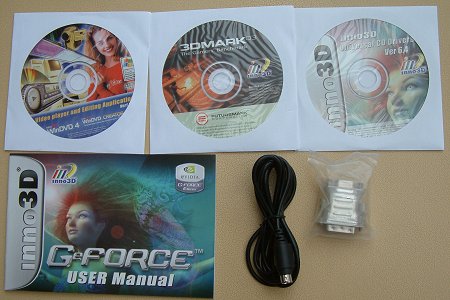Bundle and presentation

I kind of like the understated box design. Having raving monsters and hero figures doesn't make other competitor's cards any faster, does it?.

The card may be flashy, the accompanying bundle certainly isn't. It appears as if Inno3D is basing its selling strategy on low cost and potentially high performance. The accompanying manual is a little brief and covers all GeForce 6 cards in one fell swoop. It's adequate more than in-depth. Graphics card partners tend to bundle in a single range-encompassing driver/application CD. That's also true here. There's WinDVD combination v1.0 that amalgamates WinDVD4 (rather old) and WinDVD Creator (no use here). The driver CD is also perfunctory, containing only Inno3D-branded Detonator 66.31 drivers and DirectX 9.0c. Inno3D has gone the extra mile by specifying RAMsinks on this card but then fails to include even a basic overclocking program. Coolbits would have sufficed. 3DMark03 is used in lieu of a real-world game. It'll do if benchmarking is more important than gaming to you. Hardware-wise, it's also basic. A 6-foot S-Video cable and DVI dongle is all you receive.
GeForce 6xxx
It can get confusing when talking of NVIDIA's GeForce 6-series range. I've included a brief table below that delineates the main differences between each class of NV40 GPU. Note that LE versions have been omitted
| GPU | GeForce 6200 | GeForce 6600 | GeForce 6600 GT | GeForce 6800 | GeForce 6800 GT | GeForce 6800 Ultra |
| Manufacturing process | 110nm | 110nm | 110nm | 130nm | 130nm | 130nm |
| Native interface | PCI-Express | PCI-Express | PCI-Express | AGP | AGP | AGP |
| Vertex shaders | 3 | 3 | 3 | 5 | 6 | 6 |
| Render setup | 4x1 | 8x1* | 8x1 | 12x1 | 16x1 | 16x1 |
| Render outputs | 4 | 4 | 4 | 12 | 16 | 16 |
| Core speed (Mhz) | 300 | 300 | 500 | 325 | 350 | 400/425 |
| Mutli-texturing fillrate (Mpixels) | 1200 | 2400 | 4000 | 3900 | 5600 | 6400+ |
| Memory Interface | 128-bit | 128-bit | 128-bit | 256-bit | 256-bit | 256-bit |
| Memory type (usual) | DDR1 | DDR1 | DDR3 | DDR1 | DDR3 | DDR3 |
| Memory speed | 500 | 550 | 1000 | 700 | 1000 | 1100 |
| Memory bandwidth | 8GB/s | 8.8GB/s | 16GB/s | 22.4GB/s | 32GB/s | 35.2GB/s |
| Estimated street price | £80 | £115 | £150 | £210 | £250+ | £350+ |
| Notables | No Z or colour compression | 110nm manufacturing process | 500MHz core speed | 12-pipe, 12-ROP setup | 16 pipes and 256-bit | Very limited supply |
In general, GeForce 6600 GT is pretty much half of what makes up the premier 6800 GT and Ultra parts. On the premier 6800 line, NVIDIA uses either 12 or 16 (three or four quads) pixel pipelines that are linked to an equivalent number of rendering outputs via what's termed a fragment crossbar. The crossbar is designed such that pixel pipelines can feed into any rendering output. However, on GeForce 6600 GT and lower models NVIDIA has decided that the slight performance sacrifice arising from having only 4 rendering outputs linked to 8 pixel pipelines is worth the saving in die transistors and overall heat. The architectural chop will only show up in limited scenarios that don't often present themselves in modern games, so whilst it won't be as fast as a strict 8 pixel shader/ 8 ROP (render outputs) setup such as implemented on Radeon X700, having only 4 ROPs on a midrange design is actually quite good thinking.









